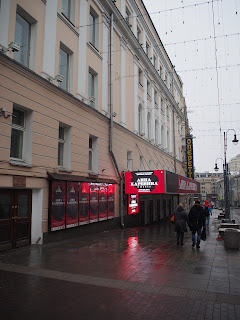JOYCE DIDONATO
Joyce DiDonato
esiintyi Musiikkitalossa produktiossaan In War & Peace – Harmony through
music yhdessä Il Pomo d’Oro orkesterin kanssa. Tällä kertaa adjektiivini
loppuvat kesken, sillä esitys oli suorastaan maaginen. Yleisö oli hiirenhiljaa
ja keskittyi nauttimaan.
Esityksen alkuosa
käsitteli sotaa, väkivaltaa, tuskaa. DiDonato esiintyi upean uskottavasti ja jo
ensimmäiset aariat – Händelin Scenes of horror, scenes of woe ja Leonardo Leon
Prendi quel ferro, o barbaro – soivat raakuutta uhkuen. Ja Händelin aarian
Pensieri, voi mi tormentaten alku oli päätähuimaava. Mikä fantastinen ääni!
Tässä kohtaa minä ainakin lakkasin hengittämästä.
Toinen osa
puolestaan käsitteli rauhaa, sopusointua. Tuntui kuin lavalla olisi ollut aivan
toinen nainen. Ääni oli toki aivan yhtä upea, mutta laulut ja esiintyminen
olivat seesteisiä ja rauhallisia. Tässä osassa pääosaan nousi DiDonaton ylivertainen
tekniikka. Aarioiden kuvioinnit iskivät kellontarkkoina ja kirkkaina. Todellista
taituruutta, joka salpasi henkeä.
Ylimääräisenä
numerona, joka oli täydellinen lopetus illalle, DiDonato lauloi sydämeenkäyvästi
Richard Wagnerin Morgenin. Sen alku ”Und Morgen wird die Sonne wieder scheinen”
kuvasti upeasti toivoa, johon koko esitys oli hyvä päättää.
Olen varma, että
pelkästään DiDonaton ääni olisi riittänyt lumoamaan yleisön, mutta esitys oli
suunniteltu kokonaisuudeksi, jossa myös valoilla, videoprojisoinneilla ja
tanssilla oli osuutensa. En varmasti ollut ainut, joka välillä unohti seurata
taustan (ja katon) videointia (Yousef Iskander) lauluun keskittyessään, mutta
silloin kun huomasin sen, oli toki pakko todeta, että ne tukivat hyvin
esityksen teemoja. Valojen (Henning Blum) käyttö oli erittäin onnistunutta ja
ne loivat hienon tunnelman Musiikkitalon muuten vähän lattealle
esiintymislavalle. Tanssi oli mielestäni ehkä kaikkein ylimääräisin osa
esitystä, vaikka tanssija-koreografi Manuel Palazzo toki tehtävästään hyvin
selvisikin.
Minun on pakko
mainita myös puvut (Vivienne Westwood), jotka kuvasivat hyvin illan teemoja. Ensimmäinen
puku oli näyttävä, jopa agressiivinen siivellisine hameineen ja toinen puku
taas toi mieleen rauhallisesti virtaavan veden.
Il Pomo d’Oro
teki koko esityksen ajan varmaa työtä. Kyseessä on todellinen maailmanluokan
barokkiorkesteri ja myös heidän paria sooloesitystään oli kiinnostavaa
kuunnella. Heidän yhteistyönsä Joyce DiDonaton kanssa oli loppuun asti hiottua
ja silti spontaanin oloista. Upea ilta kaiken kaikkiaan!














































